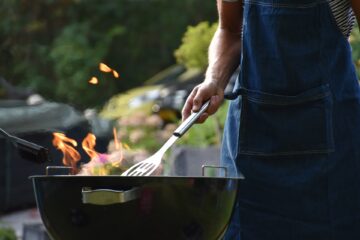Welcome to the world of BBQ and grilling, where brisket is a true superstar! This flavorful and versatile cut of beef is a favorite of many meat lovers, and it’s no wonder why. But, have you ever wondered how much a brisket will shrink when cooked? This is an important question to ask, whether you’re cooking for a crowd or just for yourself. Understanding how much a brisket will shrink can help you plan ahead, adjust your cooking techniques, and ensure that you have enough meat to go around.
Brisket is not only a delicious and popular cut of meat but also a tricky one to cook perfectly. Therefore, knowing how much a brisket will shrink when cooked is essential for achieving the desired taste, texture, and presentation. In this article, we will dive into the factors that affect brisket shrinkage, how much a brisket typically shrinks when cooked, and tips for minimizing shrinkage. By the end of this article, you’ll be a brisket expert and ready to tackle this delicious cut of meat with confidence.
What is a Brisket?
Before we get into the specifics of brisket shrinkage, let’s first talk about what a brisket actually is. A brisket is a cut of beef that comes from the chest of the cow. It’s a tough and fibrous muscle that gets a lot of exercise, which is why it’s known for being a challenging cut to cook.
A whole brisket is made up of two parts: the flat and the point. The flat is a leaner and more uniform piece of meat, while the point is a fattier and more marbled cut. Many BBQ enthusiasts prefer the point for its juicy and flavorful qualities, while others appreciate the leaner texture of the flat.
It’s important to note that when you purchase a brisket, it may be either a whole brisket or a trimmed brisket. A whole brisket will include both the flat and the point, while a trimmed brisket will only include the flat. The choice between a whole and a trimmed brisket depends on personal preference and cooking style.
Finally, brisket can come in different grades, which are based on the amount of marbling in the meat. The higher the grade, the more marbled the meat will be, which can result in a more flavorful and tender brisket. Some popular grades of brisket include Choice and Prime.
Overall, brisket is a unique and delicious cut of meat that requires some finesse to cook properly. Knowing the different parts of the brisket and their characteristics can help you choose the right cut for your cooking needs.
Factors That Affect Brisket Shrinkage
There are several factors that can affect how much a brisket will shrink when cooked. One of the main factors is the amount of fat in the brisket. As the brisket cooks, the fat will render out and cause the meat to shrink. Therefore, a fattier brisket will typically shrink more than a leaner one.
Another factor that can affect brisket shrinkage is the cooking temperature. If the brisket is cooked at too high of a temperature, it can cause the meat to shrink more than it would at a lower temperature. Additionally, the length of time the brisket is cooked can also play a role in shrinkage. Overcooking the brisket can cause it to shrink excessively.
The way the brisket is trimmed before cooking can also affect shrinkage. If too much fat is trimmed off, the brisket may end up drying out and shrinking more during cooking. On the other hand, if there is too much fat left on the brisket, it may cause the meat to shrink unevenly.
Finally, the way the brisket is cooked can impact shrinkage. For example, smoking the brisket low and slow may result in less shrinkage than cooking it quickly over high heat. The amount of moisture in the cooking environment can also affect how much the brisket will shrink. Cooking in a moist environment can help to prevent excessive shrinkage.
Understanding these factors that affect brisket shrinkage can help you make more informed decisions when cooking a brisket. By taking these factors into account, you can minimize shrinkage and achieve the desired texture and flavor in your brisket.
How Much Does a Brisket Shrink When Cooked?
Now that we understand the factors that can affect brisket shrinkage, let’s dive into the question of how much a brisket actually shrinks when cooked. The answer to this question depends on several factors, such as the amount of fat in the brisket, the cooking temperature, and the length of time the brisket is cooked.
On average, a brisket can shrink anywhere from 10% to 40% during the cooking process. This means that a 10-pound brisket can end up being anywhere from 6 to 9 pounds after it’s cooked. The amount of shrinkage will vary based on the factors mentioned above.
A fattier brisket will typically shrink more than a leaner one. This is because as the fat renders out, it takes up more space than the meat itself, causing the meat to shrink more. Additionally, cooking at higher temperatures or for longer periods of time can cause the brisket to shrink more than if it were cooked low and slow.
It’s important to keep in mind that some shrinkage is to be expected when cooking a brisket. However, there are steps you can take to minimize shrinkage, such as choosing a leaner brisket, cooking at a lower temperature, and monitoring the cooking time carefully. By taking these steps, you can help ensure that your brisket retains as much of its original size and flavor as possible.
Overall, while brisket shrinkage may be a concern for some, it’s a natural part of the cooking process. By understanding the factors that can affect shrinkage and taking steps to minimize it, you can still achieve a delicious and flavorful brisket that will be sure to impress your guests.
Tips for Minimizing Brisket Shrinkage
While some degree of shrinkage is inevitable when cooking a brisket, there are several steps you can take to minimize it and help ensure that your brisket retains as much of its original size and flavor as possible. Here are some tips for minimizing brisket shrinkage:
- Choose a leaner brisket: As we mentioned earlier, a fattier brisket will typically shrink more than a leaner one. Choosing a brisket with less fat can help minimize shrinkage during cooking.
- Trim the brisket carefully: Trimming the brisket too much or too little can both result in excess shrinkage. Take care to trim just the right amount of fat from the brisket before cooking.
- Cook at a lower temperature: Cooking the brisket at a lower temperature can help minimize shrinkage. This allows the meat to cook more slowly and evenly, which can help reduce the amount of moisture lost during cooking.
- Use a meat thermometer: Monitoring the internal temperature of the brisket with a meat thermometer can help you avoid overcooking it, which can cause excessive shrinkage.
- Wrap the brisket during cooking: Wrapping the brisket in foil or butcher paper during the cooking process can help keep the meat moist and reduce shrinkage.
- Let the brisket rest before slicing: Allowing the brisket to rest for 15 to 30 minutes before slicing can help the juices redistribute within the meat and reduce shrinkage.
By taking these steps, you can help minimize brisket shrinkage and achieve a tender, juicy, and flavorful brisket that will be sure to impress your guests.
Conclusion
In conclusion, while brisket shrinkage may be a concern for some, it’s a natural part of the cooking process. Understanding the factors that can affect shrinkage and taking steps to minimize it can help ensure that your brisket retains as much of its original size and flavor as possible.
Factors such as the amount of fat in the brisket, the cooking temperature, and the length of time the brisket is cooked can all affect how much the brisket will shrink during cooking. By choosing a leaner brisket, trimming it carefully, cooking at a lower temperature, using a meat thermometer, wrapping it during cooking, and letting it rest before slicing, you can help minimize brisket shrinkage and achieve a delicious and flavorful result.
Remember, cooking a brisket is a labor of love that requires patience, attention to detail, and a little bit of practice. By following these tips and experimenting with different techniques, you can become a brisket master and impress your friends and family with your delicious creations. So go ahead and fire up the smoker, grab a cold drink, and get ready to enjoy the mouthwatering flavors of a perfectly cooked brisket!




